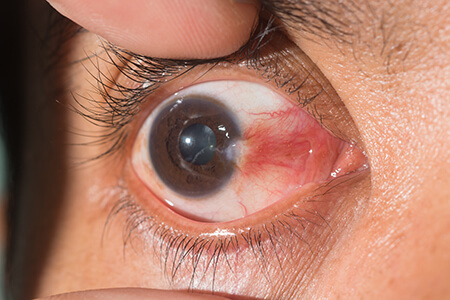Pterygium Surgery
Pterygium (pronounced tur-IJ-ee-um) is a common eye condition that affects people who spend a lot of time outdoors. Because it often affects surfers, it is also known as surfer’s eye. It can affect anyone, though, even children who don’t wear sunglasses outside.
People with pterygium have a growth of pink, fleshy tissue on the white of the eye. The growth usually forms on the side closest to the nose and grows toward the center of the eye.
Pterygium is a noncancerous lesion that usually grows slowly throughout life. It may even stop growing after a certain point. In advanced cases, a pterygium can continue growing until it covers the pupil of the eye and interferes with vision.
A pterygium may affect one or both eyes. When it affects both eyes, it is called a bilateral pterygium. Pterygium is usually not a serious condition. It can, though, cause annoying symptoms such as the feeling of having a foreign body in the eye. Sometimes the growth becomes red and irritated and requires medical treatment.
Symptoms of Pterygium
- Sometimes, a pterygium causes no symptoms other than its appearance. An enlarging pterygium, however, may cause redness and inflammation.
- A pterygium can progressively grow onto the cornea (the clear, outer layer of the eye). This can distort the shape of the cornea, causing a condition called astigmatism. The result can be blurred vision.
Symptoms of pterygium may include:
- Burning
- Gritty feeling
- Itching
- Sensation of a foreign body in the eye
- Blurred vision
Causes of Pterygium
Most experts believe that significant risk factors include:
- Prolonged exposure to ultraviolet light
- Dry eye
- Irritants such as dust and wind
Pterygium occurrence is much greater among people who live near the equator. But it also can develop in anyone who lives in a sunny climate. It’s most often seen in young adults ages 20 to 40. It appears to be more common in men than in women.
Pterygium is often preceded by a related noncancerous condition called pinguecula (pin-WEK-yoo-la). This is a yellowish patch or bump on the conjunctiva near the cornea. The conjunctiva is the thin, moist membrane on the surface of the eye.
Pinguecula has the same risk factors as pterygium, especially frequent exposure to the sun without sunglasses. Because pinguecula may prevent tears from coating the surface of your eye well, it can cause dryness and a feeling like something’s stuck in your eye. The pinguecula can also become red.
Treatment of Pterygium
See an ophthalmologist if you have symptoms of pterygium. He or she can diagnose the condition by examining the front part of your eye with a microscope called a slit lamp. Pterygium usually doesn’t require treatment if symptoms are mild. If a temporary worsening of the inflamed condition causes redness or irritation, it can be treated with:
- Lubricating eyedrops or ointments, such as Blink or Refresh drops
- Occasional use of vasoconstrictor eyedrops, such as Naphcon A
- Short course of steroid eyedrops, such as FML or Lotemax
If the lesion causes persistent discomfort or interferes with vision, it can be surgically removed during an outpatient procedure. You and your doctor may also take into account appearance and the size of the pterygium when making a decision about surgery.
Surgery has a risk of complications, one of which is the recurrence of a more aggressive lesion. So surgery is usually considered only if:
- Conservative treatments have failed
- The patient’s eyesight is at risk
- The patient is bothered by the cosmetic appearance or by comments from other people about the redness
The most often performed surgery is one that uses the patient’s own conjunctiva (surface eye tissue) or preserved amniotic membrane (placenta) to fill the empty space created by the removal of the pterygium. In this procedure, the pterygium is removed and the conjunctiva or amniotic membrane is glued or stitched onto the affected area.
Pterygium surgery typically takes 30 to 45 minutes. After surgery, patients usually need to wear an eye patch for a day or two. But they can return to work or normal activities (avoiding swimming and eye rubbing) after a few days.
Often, patients are told to use steroid eyedrops for several weeks or months. This can reduce inflammation and the chance of pterygium recurrence.
The main complication of pterygium surgery is recurrence after removal. Without a conjunctival or amniotic graft, the recurrence rate can be as high as 50%. Pterygium removal with a conjunctival or amniotic graft is associated with a much decreased recurrence risk of 5%-10%.
Surgical complications may also include corneal scarring and perforation of the white part of the eye. In some cases, surgical removal of pterygium can cause astigmatism.
Patients need to be carefully followed for a year.
About 97% of recurrences happen during the first 12 months after surgery.
Prevention of Pterygium
You may prevent pterygium and pinguecula by wearing sunglasses every day. That includes cloudy days since the damaging ultraviolet light penetrates clouds too. Choose sunglasses that block 99%-100% of both ultraviolet A (UVA) and ultraviolet B (UVB) radiation.
Wraparound sunglasses provide the best protection against ultraviolet light, dust, and wind. It’s important to protect your eyes in the car too, especially because, unlike front windshields, most car side windows do not provide adequate UV protection. You can also have a clear UV film applied to your side windows to help.
Experts also recommend wearing a hat with a brim to protect the eyes from ultraviolet light.
To keep your eyes moist in dry conditions, apply artificial tears.
